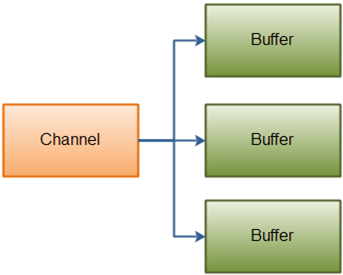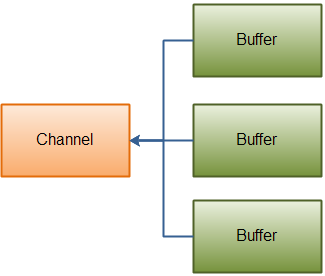Java NIO分散/聚集或向量I/O
在Java NIO中,通道提供了稱爲分散/聚集或向量I/O的重要功能。 這是一種簡單但功能強大的技術,通過這種技術,使用單個write()函數將字節從一組緩衝區寫入流,並且可以使用單個read()函數將字節從流讀取到一組緩衝區中。
Java NIO已經內置了分散/聚集支持。它可以用於從頻道讀取和寫入頻道。
分散讀取
「分散讀取」用於將數據從單個通道讀取多個緩衝區中的數據。
下面來看看分散原理的說明:

下面是執行分射讀取操作的代碼示例:
public interface ScatteringByteChannel extends ReadableByteChannel
{
public long read (ByteBuffer [] argv) throws IOException;
public long read (ByteBuffer [] argv, int length, int offset) throws IOException;
}聚集寫入
「聚集寫入」用於將數據從多個緩衝區寫入單個通道。
下面來看看聚集原則的簡單說明:

下面來看看看執行聚集寫入操作的代碼示例:
public interface GatheringByteChannel extends WritableByteChannel
{
public long write(ByteBuffer[] argv) throws IOException;
public long write(ByteBuffer[] argv, int length, int offset) throws IOException;
}基本散點/聚集示例
下面來看看兩個緩衝區的簡單例子。 第一個緩衝區保存隨機數,第二個緩衝區使用分散/聚集機制保存寫入的數據:
package com.yiibai;
import java.io.FileOutputStream;
import java.io.FileInputStream;
import java.nio.ByteBuffer;
import java.nio.channels.FileChannel;
import java.nio.channels.ScatteringByteChannel;
import java.nio.channels.GatheringByteChannel;
public class ScatterGatherIO {
public static void main(String params[]) {
String data = "Scattering and Gathering example shown in yiibai.com";
gatherBytes(data);
scatterBytes();
}
/*
* gatherBytes() is used for reading the bytes from the buffers and write it
* to a file channel.
*/
public static void gatherBytes(String data) {
String relativelyPath = System.getProperty("user.dir");
// The First Buffer is used for holding a random number
ByteBuffer buffer1 = ByteBuffer.allocate(8);
// The Second Buffer is used for holding a data that we want to write
ByteBuffer buffer2 = ByteBuffer.allocate(400);
buffer1.asIntBuffer().put(420);
buffer2.asCharBuffer().put(data);
GatheringByteChannel gatherer = createChannelInstance(relativelyPath+"/testout.txt", true);
// Write the data into file
try {
gatherer.write(new ByteBuffer[] { buffer1, buffer2 });
} catch (Exception e) {
e.printStackTrace();
}
}
/*
* scatterBytes() is used for reading the bytes from a file channel into a
* set of buffers.
*/
public static void scatterBytes() {
String relativelyPath = System.getProperty("user.dir");
// The First Buffer is used for holding a random number
ByteBuffer buffer1 = ByteBuffer.allocate(8);
// The Second Buffer is used for holding a data that we want to write
ByteBuffer buffer2 = ByteBuffer.allocate(400);
ScatteringByteChannel scatter = createChannelInstance(relativelyPath+"/testout.txt", false);
// Reading a data from the channel
try {
scatter.read(new ByteBuffer[] { buffer1, buffer2 });
} catch (Exception e) {
e.printStackTrace();
}
// Read the two buffers seperately
buffer1.rewind();
buffer2.rewind();
int bufferOne = buffer1.asIntBuffer().get();
String bufferTwo = buffer2.asCharBuffer().toString();
// Verification of content
System.out.println(bufferOne);
System.out.println(bufferTwo);
}
public static FileChannel createChannelInstance(String file, boolean isOutput) {
FileChannel FChannel = null;
try {
if (isOutput) {
FChannel = new FileOutputStream(file).getChannel();
} else {
FChannel = new FileInputStream(file).getChannel();
}
} catch (Exception e) {
e.printStackTrace();
}
return FChannel;
}
}在上述程序中,第一個緩衝區在控制檯上打印隨機輸出,第二個緩衝區在控制檯上打印「Scattering and Gathering example shown in yiibai.com」。
它還用「Scattering and Gathering example shown in yiibai.com」替換testout.txt文件的內容。
420
Scattering and Gathering example shown in yiibai.com